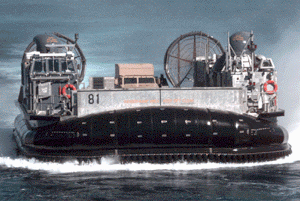 Air cushion craft are for for
transporting, ship-to-shore and across the beach, personnel, weapons,
equipment, and cargo of the assault elements of the Marine Air-Ground Task
Force. Air cushion craft are for for
transporting, ship-to-shore and across the beach, personnel, weapons,
equipment, and cargo of the assault elements of the Marine Air-Ground Task
Force.
The landing craft air cushion (LCAC) is a high-speed, over-the-beach
fully amphibious landing craft capable of carrying a 60-75 ton payload. It
is used to transport weapons systems, equipment, cargo and personnel from
ship to shore and across the beach. The advantages of air-cushion landing
craft are numerous. They can carry heavy payloads, such as an M-1 tank, at
high speeds. Their payload and speed mean more forces reach the shore in a
shorter time, with shorter intervals between trips. The air cushion allows
this vehicle to reach more than 70 percent of the world's coastline, while
conventional landing craft can land at only 15 percent of the coasts. It can travel more than 40 knots (46 mph) with a full payload in calm water.
At this speed, it has a range of 200 miles. At slower speeds, it can travel 300
miles.
Ambulatory casualties can travel in the built-in compartments. Litter
patients must ride in specially-configured medical evacuation compartments
placed in the cargo hold. When properly configured, up to 100 litter patients
can be carried in this way. Litter patients cannot be placed in the open deck of
an LCAC because it is exceedingly noisy and wet (a considerable amount of spray
comes over the deck in anything other than absolutely calm seas).
In addition to the usual pitching and rolling associated with other landing
craft, LCAC's are somewhat unstable, resulting in some degree of crabbing. This
combination can be nausea-producing in even the acclimatized individual. It is
worse at higher speeds and worse in choppy seas.
Approved for public release; Distribution is unlimited.
The listing of any non-Federal product in this CD is not an
endorsement of the product itself, but simply an acknowledgement of the source.
Operational Medicine 2001
Health Care in Military Settings
Bureau of Medicine and Surgery
Department of the Navy
2300 E Street NW
Washington, D.C
20372-5300 |
Operational Medicine
Health Care in Military Settings
CAPT Michael John Hughey, MC, USNR
NAVMED P-5139
January 1, 2001 |
United States Special Operations Command
7701 Tampa Point Blvd.
MacDill AFB, Florida
33621-5323 |
This web version is provided by
The Brookside Associates Medical Education Division.
It contains original contents from the official US Navy NAVMED P-5139, but has
been reformatted for web access and includes advertising and links that were not
present in the original version. This web version has not been approved by the
Department of the Navy or the Department of Defense. The presence of any
advertising on these pages does not constitute an endorsement of that product or
service by either the US Department of Defense or the Brookside Associates. The
Brookside Associates is a private organization, not affiliated with the United
States Department of Defense.
Contact Us · · Other Brookside
Products
|
 Air cushion craft are for for
transporting, ship-to-shore and across the beach, personnel, weapons,
equipment, and cargo of the assault elements of the Marine Air-Ground Task
Force.
Air cushion craft are for for
transporting, ship-to-shore and across the beach, personnel, weapons,
equipment, and cargo of the assault elements of the Marine Air-Ground Task
Force.